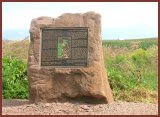This "centennial monument" was commissioned and designed in 2003 to
commemorate the incorporation of
Sackville in 1903 and to remember its
founding settlers.
[TOWN OF SACKVILLE CREST]
One century before incorporation
Sackville Parish was largely made up
of Planter, Yorkshire, and Loyalist
families. There were still Acadians in
the Parish, and Mi'kmaq nearby. All
played an important role in founding
the community we call Sackville.
|
Sackville
After a century of commercialization
and industrialization the Town of
Sackville was incorporated
February 5, 1903. Trade in cattle,
grindstones, and leather goods had
shifted to lumber, hay and stoves. This
was made possible by the bustling
seaport and a vigorous shipbuilding
industry with long-standing links to
Saint John, New England, the West
Indies, Britain and around the world,
and later by the railroad which from
1869 forged new links with the rest of
Canada. Already by the 1840s, the
centralizing of these commercial
interests, and the building of the
academies at Mount Allison,
created the central core of what is
today Sackville.
|
Tantramar's First People
Artifacts have been found in this area
from at least 4,000 years ago, when
Fundy tides had only begun to build
the vast Tantramar marshes. Over the
last 3,000 years there is evidence
suggesting at least seasonal
encampments along the edge of the
marsh, beyond the reach of the highest
tides. The Mi'kmaq thrived on the
marsh's bounty. Stories tell of
abundant waterfowl, a diversity of
fish, and hunting parties making
their way across the local landscape.
The Isthmus of Chignecto was an
important crossroads long before
European fishermen and traders made
their way here before 1600.
|
Acadians
Following Champlain's exploration of
the Bay of Fundy in 1604, Port Royal
was founded, and by the 1670s some
"Acadians" moved to the Missaguash.
Chignecto they called "Beaubassin"
and the marshes "Tintamarre"
ñ referring to the noise of waterfowl in
great numbers. Early in the 1700s the
western edges of these marshes were
being dyked and streams controlled by
"aboiteaux." Gaudet, HachÈ, Bernard,
Bourg and Richard families
built homes at Veskak, PrËs des
Bourg, PrËs des Richard, and the
largest village of all, "Tintamarre,"
with its own chapel. Following the
British capture of Fort BeausÈjour in
1755, the majority of the Acadians
were deported and their farms burned.
|
Les Acadiens
A la suite de l'exploration, en 1604,
de la baie de Fundy par Champlain,
Port Royal fut fondé, et dès les années
1670 quelques "Acadiens" allaient
s'établir dans la région de
Missaguash. Ils donnèrent le nom de
Beaubassin à Chignecto et appelèrent
les marécages "Tintamarre" en
raison des immenses volées de
sauvagine qui les occupaient. Au
début des années 1700, la construction
des digues et des aboiteaux qui
controlaient le débit des ruisseaux sur
la lisière ouest des marécages avait
commencé. Les familles Gaudet,
Haché, Bernard, Bourg et Richard
s'établirent à Veskak, Prés des Bourg,
Prés des Richard, et à Tintamarre, le
plus important de ces villages, qui
possédait sa propre église. Lorsque les
Britanniques conquirent le fort
Beauséjour, en 1755, la majorité des
Acadiens furent déportés et leurs
fermes furent brulées. |
The New England Planters
To replace the Acadians with settlers
loyal to Britain, in 1758-9
Gov. Lawrence offered land grants,
freedom of worship and representative
government in what was then called
Nova Scotia. A "township" was
surveyed and by 1762 a local
committee chose the name "Sackville"
and began allocating marshland and
woodland along with residential lots.
Settlers from Swansea, Mass. formed
the first Baptist church in Canada.
By 1767 the three villages in the
Township of Sackville had a
population of 350. Those families
which have remained include
Estabrooks, Hicks, Tower, Ward, Cole,
Oulton, Ayer among many others.
|
Yorkshire Settlers
Over 1000 settlers from
Yorkshire, England emigrated to
Nova Scota during the period
1772-1775. The Chignecto region,
including the Township of Sackville,
felt the greatest impact from this
Yorkshire immigration. Families
settling in Sackville included:
Patterson, Bulmer, Wry, Atkinson,
Anderson, Bowser, Dixon and many
others. The Yorkshire folk established
prosperous farms, erected the first
Methodist chapels in mainland Canada
including Pointe de Bute in 1788 and
one in Sackville in 1790, and
pioneered the establishment of an
important part of the Town's
industrial, mercantile and shipbuilding
base in the middle part of the 19th century.
|
Loyalists
After the American Revolution,
thousands of those loyal to the
Crown moved to Nova Scotia. Those
who came to the Township of
Sackville found land was already
hard to acquire. New Brunswick was
carved off from Nova Scotia in 1784,
leaving Sackville on the border. At
the same time, the Township was
converted into a Parish, public lands
were privatized, and authority was
shifted to the county. By 1791 a new
survey clarified land ownership, and
Tantramar's unique combination of
cattle, grindstones, tanneries and
ship building was soon being
developed. Loyalist names included
Boultenhouse, Knapp, Purdy,
Botsford and Palmer.
|
|
See Tower, Katie, "Council Considers Project To Honour Founding Of Town," Sackville Tribune-Post, 31 October 2001; Tower, Katie, "Monument To Be Unveiled In September," Sackville Tribune-Post, 30 June 2004; Fisher, Meredith, "Sackville Centennial Monument To Be Unveiled At Fall Fair", Sackville Tribune Post, 15 September 2004; "Unveiling of Centennial Monument," Sackville Tribune Post, 29 September 2004.
On the Mi'kmaq see Hamilton, Bill, "The Mi'kmaq Imprint On The Tantramar," Sackville Tribune-Post, 7 October 1998.
On the Acadians see Acadian Settlement of Tintamarre
On the Planters see Hamilton, Bill, "Imprint Left by New England Planters," Sackville Tribune-Post, 19 January 2000; Hamilton, Bill, "The Planter Prime Ministers," Sackville Tribune-Post, 21 June 2000.
On the Yorkshire settlers see Yorkshire Immigration
On the Loyalists see Hamilton, Bill, "Loyal They Remained: The Etter Family Saga," Sackville Tribune-Post, 25 August 1999.
|
![Tantramar Heritage Trust [logo]](../tht_logosm.jpg)


